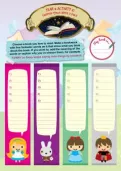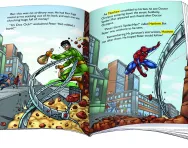Important update from TheSchoolRun
For the past 13 years, TheSchoolRun has been run by a small team of mums working from home, dedicated to providing quality educational resources to primary school parents. Unfortunately, rising supplier costs and falling revenue have made it impossible for us to continue operating, and we’ve had to make the difficult decision to close. The good news: We’ve arranged for another educational provider to take over many of our resources. These will be hosted on a new portal, where the content will be updated and expanded to support your child’s learning.
What this means for subscribers:
- Your subscription is still active, and for now, you can keep using the website as normal — just log in with your usual details to access all our articles and resources*.
- In a few months, all resources will move to the new portal. You’ll continue to have access there until your subscription ends. We’ll send you full details nearer the time.
- As a thank you for your support, we’ll also be sending you 16 primary school eBooks (worth £108.84) to download and keep.
A few changes to be aware of:
- The Learning Journey weekly email has ended, but your child’s plan will still be updated on your dashboard each Monday. Just log in to see the recommended worksheets.
- The 11+ weekly emails have now ended. We sent you all the remaining emails in the series at the end of March — please check your inbox (and spam folder) if you haven’t seen them. You can also follow the full programme here: 11+ Learning Journey.
If you have any questions, please contact us at [email protected]. Thank you for being part of our journey it’s been a privilege to support your family’s learning.
*If you need to reset your password, it will still work as usual. Please check your spam folder if the reset email doesn’t appear in your inbox.
19 unusual ways to encourage your child to read

When it comes to reading, children tend to fall into two camps – those who devour books at a rate of knots, and those who wouldn’t voluntarily pick up a book if their life depended on it.
Research from the National Literacy Trust confirms that young readers are polarised, with one in six saying they don’t read a single book in a month, while one in 10 reads 10 or more.
Common complaints, according to the Trust, are that reading is ‘boring’ or ‘geeky,’ or that they can’t find anything interesting to read – and boys are a particular concern, with fewer boys than girls reading for pleasure.


Claim A FREE Book Reviews Activity Pack!
- A huge collection of creative writing & reading comprehension resources
- Explore texts, deepen understanding, share opinions
- For Year 1 to Year 6
‘Research shows the crucial significance of children reading independently and enthusiastically,’ says Clare Bolton, campaign manager for the National Literacy Trust’s Words for Life campaign. ‘It’s more important for children’s educational success than their family’s socio-economic status, and young people who enjoy reading are more likely to read above the expected level for their age.’
So how can you turn your child from a reluctant to a rampant reader?
1. Start a reading challenge. Try making a ‘Reading Passport’ where your child earns a sticker for every book they read, with a reward such as a trip to the cinema when they've worked their way through a specified number.
2. Make it meaningful. According to research from the University of Portsmouth, children find learning to read easier if they’re taught not just phonics, but also how the English language works – for example, that the word ‘say’ is the ‘root word’ for words such as ‘saying’, ‘said’ and ‘says’. ‘The written word is about conveying meaning, not the sound of speech,’ explains lead researcher Dr Victoria Devonshire. ‘When children are taught to understand why English works the way it does, we see a leap in their ability to learn to read and write.’
3. Try before you buy. If your child starts a multitude of books but quickly loses interest, check out LoveReading4kids, where they can download extracts from thousands of children’s books to see what fires their interest.
4. Join a children’s book club. There are a number of online book clubs for kids, such as Chatterbooks or Scholastic Kids' Club, where children can upload book reviews, read excerpts from new releases, enter competitions and take part in interactive quizzes. Book Club Buddies is another great option, providing interactive book clubs that are guided by teachers and encourage conversation as well as boosting literacy skills.
5. Get topical. If your child isn’t interested in fiction, get them up to date with what’s going on in the world with First News, the children’s newspaper that presents current affairs in a child-friendly format and language.
6. Have a book swap party. Sharing books with friends is a great way to keep your child topped up with new reading material, and to encourage them to read texts that they might not otherwise have discovered, so use peer pressure positively and invite a few of your child’s friends round for a book swap.
7. Make some noise. ‘Encourage your children to read aloud – to you, friends or even their toys,’ says Clare. ‘Hearing their own voice helps practise their speaking, and builds confidence with reading.’
8. Give them easy access to books. The Tidy Books shelf (from £109) stores books with their covers on show so it’s easy for your child to find the one they want. For older readers, there’s a wall-mounted bunk bed version (from £44.95), perfect for bedtime reading.
9. Make it a family affair. ‘Get older siblings to read to younger ones,’ suggests Clare. ‘Not only does this provide some valuable time off for mums and dads, but younger children will follow their example in practising their reading later.’
10. Go visual. Comics are a great way to encourage children – boys and girls – to read, and children love choosing colourful magazines to read at home. Some studies suggest that, in some cases, they are better than text books for memory and learning! Words and pictures combined can help embed a concept.
11. Tap into their interests. If they're not keen on fiction, look for information texts about your child’s favourite hobbies and interests, whether that’s football, space, music or nature.
12. Read to your pet. The Bark and Read campaign and Burns by Your Side campaign (in Wales) encourage children to read aloud to their dog: a willing and uncritical listener. Dogs are even being taken into schools as reading companions. ‘It builds children’s confidence to a degree that we never imagined possible, and they actually look forward to reading time,’ says head teacher Claire Claydon.
13. Beat boredom with a book. Encourage your child to take a book with them whenever they go out, so they've always got something to fill the time when they're in the dentist’s waiting room or getting restless at a family gathering.
14. Branch out from school books. Bored of Biff, Chip and Kipper? Sign up for Reading Chest, enter your child’s current reading level, and they’ll send you a selection of perfectly pitched books on loan each month. From £9.95 per month.
15. Meet the maker. Look out for meet-and-greet events with children’s authors at your local library and bookshops: a great reading incentive for your child.
16. Make your child the star. Personalised books are a huge hit with children, putting them right at the heart of the story. Some even have the option of uploading your own photos.
17. Play games based on books. Knock up a cape and wand so they can re-enact scenes from Harry Potter, make playdough or cardboard models of the characters from their latest book, or go on a Famous Five-style adventure.
18. Try a boovie – an interactive "book in motion". By combining printed words with animated images, pop-up definitions, optional audio narration and a soundtrack, Galdo's Gift offers a digital alternative to a picture book for a new generation.
19. Be a model parent. ‘The best reading role models are in the home: brothers, fathers, grandfathers; mothers, sisters, grandmothers, so make sure your kids see you reading,’ says author and Words for Life supporter James Patterson. ‘It doesn’t have to be books: reading the newspaper is good too.’








